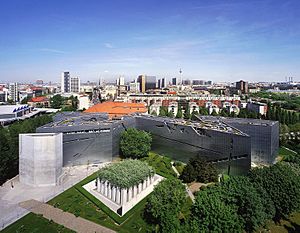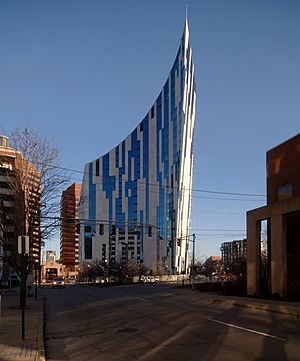Daniel Libeskind facts for kids
Quick facts for kids
Daniel Libeskind
|
|
|---|---|
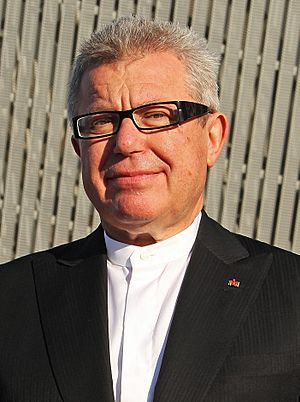
Libeskind in front of his extension to the Bundeswehr Military History Museum in Dresden, 2011
|
|
| Born | May 12, 1946 Łódź, Poland
|
| Alma mater | The Cooper Union University of Essex |
| Occupation | Architect |
| Spouse(s) |
Nina Lewis Libeskind
(m. 1969) |
| Children | 3 |
| Practice | Studio Daniel Libeskind |
| Buildings | Felix Nussbaum Haus Jewish Museum Berlin Imperial War Museum North Contemporary Jewish Museum Royal Ontario Museum (expansion) One World Trade Center (2002) The Ascent at Roebling's Bridge |
Daniel Libeskind (born May 12, 1946) is a famous Polish-American architect, artist, and professor. He started his own company, Studio Daniel Libeskind, in 1989 with his wife, Nina. He is the main architect there.
Libeskind is well-known for designing the Jewish Museum Berlin in Germany, which opened in 2001. He also gained international attention in 2003. This was when he won a competition to create the master plan for rebuilding the World Trade Center site in Lower Manhattan, New York.
Some of his other famous buildings include the addition to the Denver Art Museum in the United States. He also designed the Grand Canal Theatre in Dublin, Ireland, and the Imperial War Museum North in England. The Michael Lee-Chin Crystal at the Royal Ontario Museum in Canada is another one of his designs. His work has been shown in major museums worldwide.
Contents
Early Life and Education
Daniel Libeskind was born in Łódź, Poland. His parents, Dora and Nachman Libeskind, were Polish Jews who survived the Holocaust. When he was young, Daniel learned to play the accordion. He became very good at it and even performed on Polish television in 1953. In 1959, he won a scholarship and played alongside a young Itzhak Perlman, a famous violinist. Libeskind lived in Poland for 11 years and still speaks Polish.
In 1957, his family moved to Israel, living in a kibbutz (a community farm) and then Tel Aviv. In 1959, they moved to New York City. Libeskind wrote in his book, Breaking Ground, that his time on the kibbutz made him care about "green architecture." This means designing buildings that are good for the environment.
In New York, Libeskind lived in a cooperative housing development in the Bronx. He went to the Bronx High School of Science. His father worked in a print shop in Lower Manhattan. Daniel watched the original World Trade Center being built in the 1960s. He became a United States citizen in 1965.
Libeskind studied at Cooper Union for the Advancement of Science and Art from 1965 to 1970. He earned his architecture degree there. He also got a postgraduate degree in the history and theory of architecture from the University of Essex in 1972.
Architectural Career
Libeskind started his career teaching architecture at different places around the world. From 1978 to 1985, he led the Architecture Department at Cranbrook Academy of Art in Michigan. His first real building project began in Milan in the late 1980s.
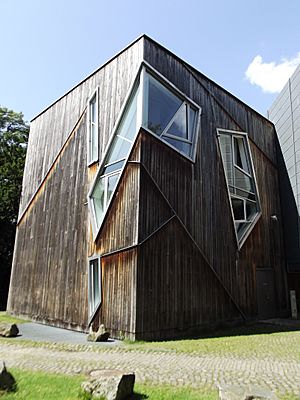
Libeskind completed his first building, the Felix Nussbaum Haus in Osnabrück, Germany, in 1998. He was 52 years old at the time. Before this, some critics thought his designs were too difficult to build. In 1987, he won a design competition for housing in West Berlin. However, the Berlin Wall fell soon after, and the project was canceled.
He won his first four design competitions, including the Jewish Museum Berlin in 1989. This museum was the first dedicated to the Holocaust in World War II. It opened in 2001 and received great praise from around the world. This was his first big international success. A glass courtyard was added to the museum in 2007, also designed by Libeskind. The Academy of the Jewish Museum Berlin, another Libeskind design, was finished in 2012.
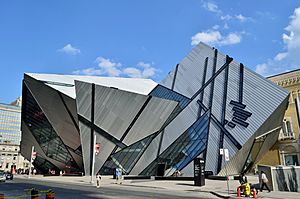
In 2003, the Lower Manhattan Development Corporation chose Libeskind to lead the rebuilding of the World Trade Center. This site was destroyed in the September 11, 2001 attacks. His idea for the site, called Memory Foundations, was very popular when it was shown to the public. However, the final design was changed quite a bit.
Libeskind was the first architect to win the Hiroshima Art Prize. This award is given to artists whose work helps promote understanding and peace between countries. Many of his projects explore the strong connections between memory and architecture.
Studio Daniel Libeskind is located near the World Trade Center site in New York. The studio has designed many cultural and business buildings. These include museums, concert halls, universities, homes, hotels, and shopping centers. Some of their recent projects include the MO Museum in Lithuania and the Zlota 44 residential tower in Poland.
Other Designs
Besides buildings, Libeskind has also designed objects, furniture, and other items for building interiors. He has worked with companies like Fiam, Artemide, and Jacuzzi.
His design projects also include sculptures. For example, the Polderland Garden of Love and Fire in the Netherlands is a permanent art installation finished in 1997. In 2015, he designed the Life Electric sculpture in Italy, dedicated to the scientist Alessandro Volta.
Libeskind has also designed sets for operas. He created sets for "The Architect" in 1998 and "Tristan und Isolde" in 2001. He also designed sets and costumes for "Intolleranza" and "Saint Francis of Assisi".
Teaching and Academia
Daniel Libeskind was the head of the Architecture Department at Cranbrook Academy of Art from 1978 to 1985. During this time, he created exhibitions, wrote essays and books, and made large-scale art pieces. These included three "machines" called the Reading Machine, Writing Machine, and Memory Machine. These machines were shown at the Venice Biennale in 1985, where Libeskind and his team won an award.
Libeskind has taught at many universities. These include University of Kentucky, Yale University, UCLA, and Harvard University. He continues to teach students at various universities today.
Notable Projects
Here are some of Daniel Libeskind's important projects:
Completed Buildings
- 1989–2001 Jewish Museum Berlin – Berlin, Germany
- 1995–1998 Felix Nussbaum Haus – Osnabrück, Germany
- 1997–2001 Imperial War Museum North – Greater Manchester, England
- 2000–2006 Extension to the Denver Art Museum – Denver, Colorado, United States
- 2001–2003 Danish Jewish Museum – Copenhagen, Denmark
- 2002–2007 Michael Lee-Chin Crystal, extension to Royal Ontario Museum – Toronto, Canada
- 2004–2008 The Ascent at Roebling's Bridge, residential building – Covington, Kentucky, United States
- 2004–2010 Grand Canal Square, Grand Canal Theatre – Dublin, Ireland
-
2001–2011 Military History Museum – Dresden, Germany
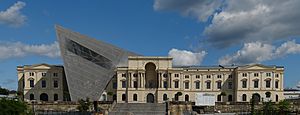 Military History Museum (2010), Dresden
Military History Museum (2010), Dresden - 2006–2011 Reflections at Keppel Bay, apartment blocks – Keppel Bay, Singapore
- 2007–2017 Złota 44, residential tower – Warsaw, Poland
-
2014-2017 National Holocaust Monument – Ottawa, Canada
 National Holocaust Monument (2017), Ottawa
National Holocaust Monument (2017), Ottawa - 2017-2018 MO Museum – Vilnius, Lithuania
Ongoing Projects
- 2002-ongoing World Trade Center master plan – New York City, New York
- 2012-2021 Lotte Mall Songdo & Officetel, Songdo, South Korea
- 2017-2020 East Thiers Station, Nice, France
Awards and Recognition
Daniel Libeskind has received many awards for his work:
- He was the first architect to win the Hiroshima Art Prize in 2001. This award is for artists who promote peace.
- In 2003, he received the Leo Baeck Medal for his work promoting kindness and fairness.
- He won the AIANY Merit Award in 2018 for the National Holocaust Monument in Ottawa, Canada.
- He was made a Fellow of the American Institute of Architects in 2016.
- He received an honorary degree from the University of Ulster in 2009 for his great work in architecture.
- He won the MIPIM award in 2014 for the KoBogen project.
- He received the Goethe Medal in 2000 for his contributions to culture.
- Time magazine gave his Felix Nussbaum Haus a Best Design Award in 1998.
- He won the First Prize Stone Lion Award at the Venice Biennale in 1985.
Personal Life
Daniel Libeskind met his wife and business partner, Nina Lewis, in 1966. They got married a few years later. Instead of a traditional honeymoon, they traveled across the US to visit buildings designed by Frank Lloyd Wright. Nina is a co-founder of Studio Daniel Libeskind.
Libeskind has lived in many places, including New York City, Toronto, and Germany. He is a citizen of both the U.S. and Israel.
Daniel and Nina Libeskind have three children: Lev, Noam, and Rachel.
Images for kids
See also
 In Spanish: Daniel Libeskind para niños
In Spanish: Daniel Libeskind para niños


